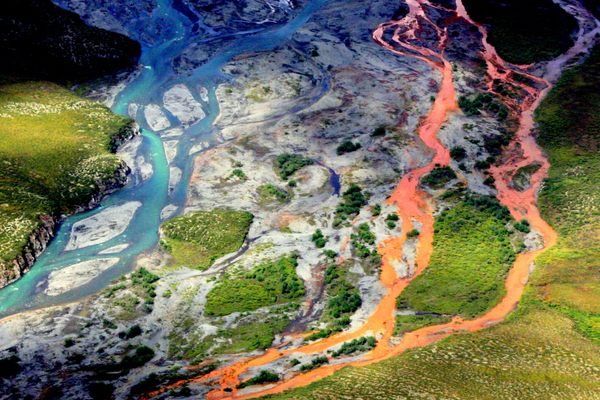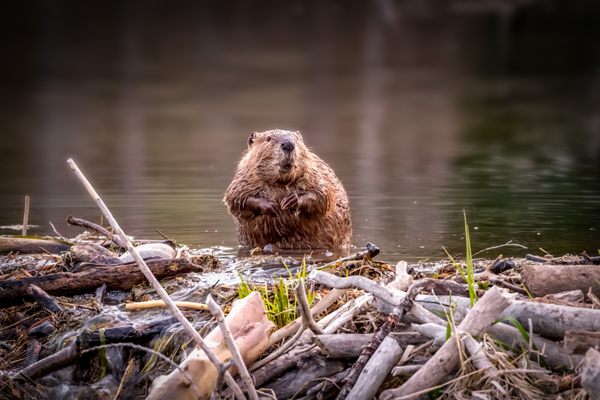The World’s Grossest Rivers
Pollution in the Citarum River, Indonesia (photograph by MangAndri Kasep)
It’s hard to overstate the importance of rivers in human history. They incubated great civilizations, created massive, world-upending floods, are sacred to major religions, and facilitated travel, commerce, and cultural exchange. They inspired ancient poets and modern songwriters. They can be a very pleasant place to spend an afternoon on a raft.
How has humanity treated rivers in return? By abusing them in all sorts of creative ways, resulting in some of the grossest rivers in the world. Here are eight of them.
THE CITARUM
Indonesia
Railway bridge across the Citarum, Tanjungpura (1920-35) (via Tropenmuseum)
The title of “World’s Most Polluted River” has a pathetic number of contenders, but current wisdom grants the dubious honor to the Citarum, 40 miles east of Jakarta, Indonesia.
According to an April 2014 article in the Guardian on a documentary from Unreported World, the 186-mile waterway contains a horrifying mixture of toxins and garbage, all while being the primary source of water for 30 million people. Some 200 textile plants line the river, dumping all manner of industrial waste, and garbage clutters the murky water from bank to bank.
MATAPEDIA
Canada
Rock snot lurks beneath the beauty (photograph by Marjolaine B.)
Human pollution can impact rivers in less obvious ways. In 2006, the bottom of the otherwise pristine Matapédia River in Quebec was found to be carpeted in squishy, green rock snot.
Rock snot, or didymo (Didymosphenia geminata), is a type of invasive algae that, in addition to being disgusting, threatens salmon and other fragile wildlife, things which are important both to the ecosystem and economy of the area. Scientists believe that global warming has encouraged the growth of this once rare algae, not just in the Matapédia River, but in rivers and lakes around the world.
Rock Snot (photograph by David Perez)
RARITAN RIVER
United States
The Raritan River in New Jersey (photograph by Dendroica cerulea)
In 2013, a man named Doug Cutle posted a photo of a truly repulsive looking, eel-like creature he fished out of the Raritan River in Northern New Jersey, creating a viral sensation. The river is in fact lovely in places and popular with fishermen and boaters, but anything that houses such a creepy creature counts as completely gross. This is doubly so since the thing, which is a sea lamprey, was much, much bigger than any respectable sea lamprey ought to be. Sea lampreys, large or small, are parasitic and latch onto fish, digesting their flesh a little at a time.
The Raritan is not alone, as terrifying as that sounds. Sea lampreys are becoming more common in American waterways — possibly due to dam removal and general messing with ecology — and are considered dangerous and invasive in the Great Lakes where they can overwhelm ecosystems. They are also a delicacy in some parts of the world, but not in the United States. (It’s thought that Henry I of England died from eating too many of them despite warnings from his doctors, and this led to a war of succession.)
Parasitic un-pleasantness (from the 1851 Proceedings of the Zoological Society of London)
THE GANGES
India
Wading along the Ganges (photograph by Ryan/Wikimedia)
Possibly no river better represents a culture and history than the Ganges does for India. The 1,500 plus mile waterway begins high in the Himalayas and empties into the Bay of Bengal, sometimes running clear, sometimes running murky. A sacred place for Hindus, millions of pilgrims bathe in the Ganges each year, despite it also being the sustaining waterway for millions and containing raw sewage, garbage, industrial waste, and a myriad of pollutants that includes remains of the dead.
The tradition of burning the dead on the Ganges has led to cremains overwhelming parts of the river (and even plans to bring in turtles to consume the ash). The Indian government is well aware of the toxic dangers presented by the river, and with the help and support of Hindu Holy Men, large scale efforts at cleanup have begun. It is hoped that multi-tiered sustainability plans will allow centuries of tradition to be respected even as the river heals.
Funerals along the Ganges in Varanasi (photograph by Arian Zwegers)
OHIO RIVER
United States
A steel plant near Pittsburgh at the Ohio River (1973 photograph from the EPA)
Over 226 million tons of toxic waste were dumped into American waterways in 2010 alone. Although the burden is shared by many large and small rivers, the Ohio usually takes the largest hit with 32,111,718 pounds of waste that year. On top of that, more than one aging city sewer system along the river has a tendency to overflow with raw sewage into the river.
Swimming is closed in those areas, thankfully. The 981 mile river runs from Pittsburgh, Pennsylvania, to Cairo, Illinois, and is the source of drinking water for three million people, though it’s heavily treated before it reaches to public. The river itself has long been an economic lifeline, and conservation efforts are underway.
YANGTZE
China
A factory on the Yangtze (via Wikimedia)
In 2006, the river dolphin species Baiji, was declared functionally extinct, owing largely to the pollution and degradation of their main habitat — China’s Yangtze River.
The third longest river in the world, millions of people depend on the Yangtze for water and livelihoods, but it suffers tremendously from the dumping of agricultural and industrial waste in mass quantities. The problem is hardly invisible, either, with pollution occasionally causing the river to run bright red.
River dolphin gone extinct (via Wikimedia)
MATANZA-RIACHUELO RIVER
Argentina
Industry at the Rocha Bend of the Riachuelo (photograph by Alex Proimas)
For such a vibrant and sophisticated city, Buenos Aires has shockingly primitive water treatment and waste facilities. This has led to the notorious 65 mile Matanza-Riachuelo River, which runs through the city, is made worse by some 100 open-air garbage dumps.
On top of that, the beleaguered waterway has it’s share of industrial waste. Thankfully, in 2014 the Argentinian government finally initiated a large scale investment in the cleanup of the river.
RIO TINTO RIVER
Spain
Acid mine drainage on the Rio Tinto (photograph by Carol Stoker/NASA)
The amount of pollution caused by human beings may have exploded in the past couple of centuries, but it is by no means new. Spain’s acidic and weirdly colored Rio Tinto is an alien-looking testament to this fact, since it’s thought that industrial mining for copper, silver, and gold started along the river in 3000 BC and continues to this day.
The red-flowing river is home to super-tough bacteria that feed on mineral deposits and are studied by exobiologists seeking life that might survive in the harsh conditions on extraterrestrial planets. Yes, it’s that harsh.
It’s no accident that the more people that depend on a river, the more likely it is to be completely and totally gross. The true terror here isn’t gooey parasites or rock snot or even a carelessly tossed plastic bottle that is just one of millions, but rather ecosystems thrown out of balance in obvious and not so obvious ways by the human beings who could not survive without them.
Discover more stories of the world’s water on Atlas Obscura >









Follow us on Twitter to get the latest on the world's hidden wonders.
Like us on Facebook to get the latest on the world's hidden wonders.
Follow us on Twitter Like us on Facebook